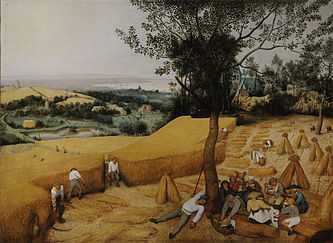Pieter Bruegel the Elder
| Pieter Bruegel the Elder | |
|---|---|
 The Painter and The Connoisseur, c. 1565 is thought to be Bruegel's self-portrait. | |
| Born |
Pieter Brueghel c. 1525 Breda or Breugel, Duchy of Brabant, Habsburg Netherlands (modern-day Netherlands) |
| Died |
9 September 1569 (aged 44) Brussels, Duchy of Brabant, Habsburg Netherlands (modern-day Belgium) |
| Known for | Painting, printmaking |
| Notable work | The Blind Leading the Blind, Landscape with the Fall of Icarus, The Hunters in the Snow, The Peasant Wedding |
| Movement | Dutch and Flemish Renaissance |
Pieter Bruegel (also Brueghel) the Elder (Dutch: [ˈpitər ˈbrøːɣəl]; c. 1525 – 9 September 1569) was a Dutch Renaissance painter and printmaker from Brabant, known for his landscapes and peasant scenes (so called genre painting). He is sometimes referred to as the "Peasant Bruegel". From 1559, he dropped the "h" from his name and signed his paintings as Bruegel.
Life
There are two sources for Bruegel's biography. The first one is Lodovico Guicciardini's account of the Low Countries, and the second one is Karel van Mander's 1604 Schilder-boeck.[1] Lodovico Guicciardini reports that he was born in Breda, but according to van Mander, he was born in Breugel near the (now Dutch) town of Breda. He was an apprentice of Pieter Coecke van Aelst, whose daughter Mayken he later married. He spent some time in France and Italy, and then went to Antwerp, where in 1551 he was accepted as a master in the painter's guild. He traveled to Italy soon after, and then returned to Antwerp before settling in Brussels permanently 10 years later.
He received the nickname "Peasant Bruegel" or "Bruegel the Peasant" for his practice of dressing up like a peasant in order to socialize at weddings and other celebrations, thereby gaining inspiration and authentic details for his genre paintings. He died in Brussels on 9 September 1569 and was buried in the Kapellekerk.
Historical background
Bruegel was born at a time of extensive change in Western Europe. Humanist ideals from the previous century influenced artists and scholars in Europe. Italy was at the end of their High Renaissance of arts and culture, when artists such as Michelangelo and Leonardo da Vinci painted their masterpieces. In 1517, about eight years before Bruegel's birth, Martin Luther created his Ninety-Five Theses and began the Protestant Reformation in neighboring Germany. The Catholic Church impinged increasingly more upon the European way of life and art. Perhaps most importantly for artists, the Council of Trent, which concluded in 1563, determined what art was appropriate in Catholic states.
At this time, the Netherlands was divided into seventeen provinces, some of which wanted separation from the Catholic Church, which controlled the provinces from their bastion in Spain. The Netherlands was influenced by the newly Lutheran Germany to the east and the newly Anglican England to the west, as evidenced by the rise of Protestantism. Since the Habsburg monarchs of Spain were the enforcers of the Catholic Church and the Catholic Counter-Reformation in Western Europe, Protestantism in the Netherlands came heavily under fire.
The Spanish monarch, Charles V, Holy Roman Emperor, promulgated the Edict of Blood in 1550. Death was the penalty for heresy to the Catholic Church; however, Charles did not enforce this edict. His son, Philip II of Spain, did enforce the Edict of Blood and his actions became a source of great unrest in the Netherlands during the 1560s. Calvinism became increasingly popular in the Netherlands despite the threat of death. Philip’s murder plot against a Dutch prince, William the Silent, the ever-present Spanish soldiers led by the hated Fernando Álvarez de Toledo, 3rd Duke of Alba and Calvinist riots brought the Netherlands to the brink of rebellion.
This was the atmosphere in which Bruegel reached the height of his career as a painter. Two years before Bruegel's death, the Eighty Years' War began between the Netherlands (led by William the Silent) and Spain. Although Bruegel did not live to see it, seven provinces became Protestant, while the other ten remained under Catholic control at the end of the war.[2]
Subjects
Pieter Bruegel specialized in genre paintings populated by peasants, often with a landscape element, but he also painted religious works. Making the life and manners of peasants the main focus of a work was rare in painting in Bruegel's time, and he was a pioneer of the genre painting. His earthy, unsentimental but vivid depiction of the rituals of village life—including agriculture, hunts, meals, festivals, dances, and games—are unique windows on a vanished folk culture, though still characteristically of Belgian life and culture today, and a prime source of iconographic evidence about both physical and social aspects of 16th century life. For example, his famous painting Flemish Proverbs, originally The Blue Cloak illustrates dozens of then-contemporary aphorisms, many of which still are in use in current Flemish, French, English and Dutch), and Children's Games shows the variety of amusements enjoyed by young people. His winter landscapes of 1565 (e.g. The Hunters in the Snow) are taken as corroborative evidence of the severity of winters during the Little Ice Age.
Using abundant spirit and comic power, he created some of the very early images of acute social protest in art history. Examples include paintings such as The Fight Between Carnival and Lent (a satire of the conflicts of the Protestant Reformation) and engravings like The Ass in the School and Strongboxes Battling Piggybanks.[3] On his deathbed, he reportedly ordered his wife to burn the most subversive of his drawings to protect his family from political persecution resulting from conflicts between the Catholic Church and the Protestant Reformation.
The sins and virtues
During the late 1550s in Antwerp, Bruegel designed engravings for the leading publisher of the city, Hieronymous Cock, at the House of the Four Winds. He achieved the greatest success with a series of allegories: The Seven Deadly Sins and The Virtues. It is easy to see his compatriot Hieronymous Bosch's influence in these engravings: the sinners are grotesque and unidentifiable while the allegories of virtue often wear odd headgear.[4]
Peasants
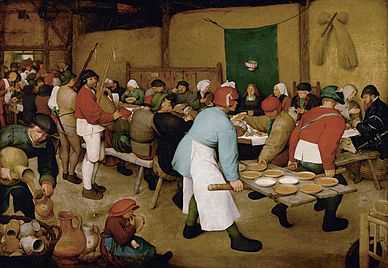
By 1558, Bruegel began painting more than drawing or carving. He primarily painted religious scenes in a Belgian setting, such as in his paintings, Conversion of Paul and The Sermon of St. John the Baptist. In the 1560s, Bruegel began painting the ordinary life of peasants. Often Bruegel painted a community event, as in The Peasant Wedding and The Fight Between Carnival and Lent. In paintings like The Peasant Wedding, Bruegel painted individual, identifiable people while the people in The Fight Between Carnival and Lent are unidentifiable, muffin-faced allegories of greed or gluttony.
Although Bruegel often painted scenes of carousing and community gatherings, he often accurately depicted cripples or people with disabilities. Perhaps one of Bruegel’s most famous paintings was The Blind Leading the Blind. Not only was Bruegel's subject matter unusual, but it also depicted a quote from the Bible: "If the blind lead the blind, both shall fall into the ditch" (Matthew 15:14). Using the Bible to interpret this painting, the six blind men are symbols of the blindness of mankind in pursuing earthly goals instead of focusing on Christ's teachings.
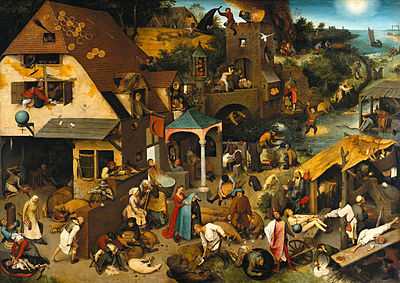
Even if Bruegel's subject matter was unconventional, the religious ideals and proverbs driving his paintings were typical of the Northern Renaissance. The Flemish provided a large artistic audience for proverb-filled paintings because proverbs were well known and recognizable as well as entertaining. One of Bruegel's most famous paintings was Netherlandish Proverbs, painted in 1559. The majority of Bruegel's paintings have many different actions occurring at once, but this painting, with over 110 proverbs, must have been one of his most symbolically laden paintings.[5]
Months of the year
_-_Google_Art_Project.jpg)
Paintings of proverbs were not Bruegel's only subjects. In 1565, a wealthy patron in Antwerp, Niclaes Jonghelinck, commissioned him to paint a series of paintings of each month of the year. Today, only five of these paintings survive and some of the months are paired to form a general season. Traditional Flemish books of hours (e.g., the Très Riches Heures du Duc de Berry;[6] 1416) had calendar pages that included depictions of what the social life, the weather, and the landscape supposedly would have looked like for that month.
Bruegel's paintings were on a larger scale than a typical calendar page painting, each one approximately three feet by five feet. For Bruegel, this was a large commission (the size of a commission was based on how large the painting was) and an important one. In 1565, the Calvinist riots began and it was only two years before the Eighty Years' War broke out. Bruegel may have felt safer with a secular commission so as to not offend Calvinist or Catholic.[7] Some of the most famous paintings from this series included The Hunters in the Snow (December–January) and The Harvesters (August).
Family
Pieter the Elder had two sons: Pieter Brueghel the Younger and Jan Brueghel the Elder (both changed their name to Breughel). Their grandmother, Mayken Verhulst, trained the sons because "the Elder" died when both were very small children. The older brother, Pieter Brueghel, was not the better painter of the two; he copied his father's style but without any degree of great talent. Jan was more successful; he turned to the Baroque style and even collaborated with Peter Paul Rubens on the Allegory of Sight.[8]
Other members of the family include Pieter Coecke van Aelst and Mayken Verhulst (father-in-law and mother-in-law to Pieter Bruegel the Elder), Jan van Kessel, senior (grandson of Jan Bruegel the Elder) and Jan van Kessel, junior. Through David Teniers, the family is also related to the whole Teniers family of painters and the Quellinus family of painters and sculptors, since Jan-Erasmus Quellinus married Cornelia, daughter of David Teniers the Younger.
| Brueghel family tree | |||||||||||||||||||||||||||||||||||||||||||||||||||||||||||||||||||||||||||||||||||||||||||||||||||||||||||||||||||||||||||||||||||||||||||||||||||||||||||||||||||||||||||||||||||||||||||||||||||||||||||||||||||||||||||||||||||||||||||||||||||||||||||||||||||||||||||||||||||||||||||||||||||||||||||||||
|---|---|---|---|---|---|---|---|---|---|---|---|---|---|---|---|---|---|---|---|---|---|---|---|---|---|---|---|---|---|---|---|---|---|---|---|---|---|---|---|---|---|---|---|---|---|---|---|---|---|---|---|---|---|---|---|---|---|---|---|---|---|---|---|---|---|---|---|---|---|---|---|---|---|---|---|---|---|---|---|---|---|---|---|---|---|---|---|---|---|---|---|---|---|---|---|---|---|---|---|---|---|---|---|---|---|---|---|---|---|---|---|---|---|---|---|---|---|---|---|---|---|---|---|---|---|---|---|---|---|---|---|---|---|---|---|---|---|---|---|---|---|---|---|---|---|---|---|---|---|---|---|---|---|---|---|---|---|---|---|---|---|---|---|---|---|---|---|---|---|---|---|---|---|---|---|---|---|---|---|---|---|---|---|---|---|---|---|---|---|---|---|---|---|---|---|---|---|---|---|---|---|---|---|---|---|---|---|---|---|---|---|---|---|---|---|---|---|---|---|---|---|---|---|---|---|---|---|---|---|---|---|---|---|---|---|---|---|---|---|---|---|---|---|---|---|---|---|---|---|---|---|---|---|---|---|---|---|---|---|---|---|---|---|---|---|---|---|---|---|---|---|---|---|---|---|---|---|---|---|---|---|---|---|---|---|---|---|---|---|---|---|---|---|---|---|---|---|---|---|---|---|---|---|
| |||||||||||||||||||||||||||||||||||||||||||||||||||||||||||||||||||||||||||||||||||||||||||||||||||||||||||||||||||||||||||||||||||||||||||||||||||||||||||||||||||||||||||||||||||||||||||||||||||||||||||||||||||||||||||||||||||||||||||||||||||||||||||||||||||||||||||||||||||||||||||||||||||||||||||||||
| Notes:
| |||||||||||||||||||||||||||||||||||||||||||||||||||||||||||||||||||||||||||||||||||||||||||||||||||||||||||||||||||||||||||||||||||||||||||||||||||||||||||||||||||||||||||||||||||||||||||||||||||||||||||||||||||||||||||||||||||||||||||||||||||||||||||||||||||||||||||||||||||||||||||||||||||||||||||||||
Work referenced in others' work
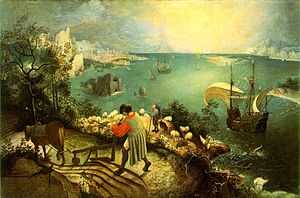
His painting Landscape with the Fall of Icarus is the subject of the 1938 poem "Musée des Beaux Arts" by W. H. Auden:
In Breughel's Icarus, for instance: how everything turns away
Quite leisurely from the disaster; the ploughman
Have heard the splash, the forsaken cry,
But for him it was not an important failure; the sun shone
As it had to on the white legs disappearing into the green
Water, and the expensive delicate ship that must have seen
Something amazing, a boy falling out of the sky,
Had somewhere to get to and sailed calmly on.[1]
- ^ Foote, Timothy (1986). The World of Bruegel. Time-Life Library. p. 149.
It also was the subject of a 1960 poem by William Carlos Williams and was referenced in Nicolas Roeg's 1976 science fiction film The Man Who Fell to Earth.
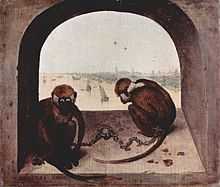
Bruegel's painting Two Monkeys was the subject of Wisława Szymborska 1957 poem, "Brueghel's Two Monkeys".[9]
Russian film director Andrei Tarkovsky referenced Bruegel's paintings in his films several times, notably Solaris (1972) and The Mirror (1975).
His 1564 painting The Procession to Calvary inspired the 2011 Polish-Swedish film co-production The Mill and the Cross, in which Bruegel is played by Rutger Hauer.
Bruegel's paintings in the Kunsthistorisches Museum are shown in the 2012 film, Museum Hours, where his work is discussed at length by a guide.
It is believed that his painting The Hunters in the Snow influenced the classic short story with the same title written by Tobias Wolff and featured in In the Garden of the North American Martyrs.
Seamus Heaney referenced Breughel in his poem "The Seed Cutters".
David Jones references the painting The Blind Leading the Blind in his World War One prose-poem In Parenthesis: 'the stumbling dark of the blind, that Breughel knew about - ditch circumscribed'.
Michael Frayn, in his novel Headlong, invents a lost panel from the 1565 Months series, which triggers a mad conflict between an art (and money) lover and the boor who possesses it. Much thought is spent on Bruegel's secret motives for painting it.
Selected works
There are about 45 authenticated surviving paintings, one third of which are in the Kunsthistorisches Museum in Vienna. A number of others are known to have been lost. There are a large number of drawings. Bruegel only etched one plate himself, The Rabbit Hunt, but designed many engravings and etchings, mostly for the Cock publishing house.
- Twelve Proverbs, 1558, Museum Mayer van den Bergh, Antwerp
- Naval Battle in the Gulf of Naples, 1560, Galleria Doria-Pamphilj, Rome
- The Fall of the Rebel Angels 1562, Royal Museums of Fine Arts of Belgium, Brussels
- The "Little" Tower of Babel, c. 1563, Museum Boymans-van Beuningen, Rotterdam
- The Procession to Calvary, 1564, Kunsthistorisches Museum, Vienna
- The Adoration of the Kings, 1564, The National Gallery, London
- Massacre of the Innocents, c. 1567, versions at Royal Collection, Kunsthistorisches Museum, Vienna, at Brukenthal National Museum, Sibiu,[10] and at Upton House, Banbury
- Winter Landscape with a Bird Trap, 1565, Royal Museums of Fine Arts of Belgium, Brussels, inv. 8724
- Landscape with Christ and the Apostles at the Sea of Tiberias, 1553, probably with Maarten de Vos, private collection
- Ass at School, 1556, drawing, Print room, Berlin State Museums
- Parable of the Sower, 1557, Timken Museum of Art, San Diego
- Landscape with the Fall of Icarus, c.1554–55, Royal Museums of Fine Arts of Belgium, Brussels – Note: Now seen as a copy of a lost authentic Bruegel painting[11]
- The Blue Cloak (or Flemish Proverbs), 1559, Gemäldegalerie, Berlin
- The Fight Between Carnival and Lent, 1559, Kunsthistorisches Museum, Vienna
- Portrait of an Old Woman, 1560, Alte Pinakothek, Munich
- Children's Games, 1560, Kunsthistorisches Museum, Vienna
- Temperance, 1560
- The Suicide of Saul (Battle Against The Philistines on the Gilboa), 1562, Kunsthistorisches Museum, Vienna
- Two Small Monkeys, 1562, Staatliche Museen, Gemäldegalerie, Berlin
- The Triumph of Death, c. 1562, Museo del Prado, Madrid
- Dulle Griet (Mad Meg), c. 1562, Museum Mayer van den Bergh, Antwerp
- The Tower of Babel, 1563, Kunsthistorisches Museum, Vienna
- Flight To Egypt, 1563, Courtauld Institute Galleries, London
- The Death of the Virgin, 1564, (grisaille), Upton House, Banbury
- The Months, a cycle of probably six paintings of the months or seasons, of which five remain:
- The Hunters in the Snow (Dec.–Jan.), 1565, Kunsthistorisches Museum, Vienna
- The Gloomy Day (Feb.–Mar.), 1565, Kunsthistorisches Museum, Vienna
- The Hay Harvest (June–July), 1565, Lobkowicz Palace at the Prague Castle Complex, Czech Republic
- The Harvesters (Aug.-Sept.), 1565, Metropolitan Museum of Art, New York
- The Return of the Herd (Oct.–Nov.), 1565, Kunsthistorisches Museum, Vienna
- Christ and the Woman Taken in Adultery (1565), Courtauld Institute of Art, London
- The Calumny of Apelles, 1565, drawing, British Museum, London
- The Painter and the Connoisseur, drawing, c. 1565, Albertina, Vienna
- Preaching of John the Baptist, 1566, Museum of Fine Arts (Budapest)
- The Census at Bethlehem, 1566, Royal Museums of Fine Arts of Belgium, Brussels
- The Wedding Dance, c. 1566, Detroit Institute of Arts, Detroit
- Conversion of Paul, 1567, Kunsthistorishes Museum, Vienna
- The Land of Cockaigne, 1567, Alte Pinakothek, Munich
- The Adoration of the Magi in the Snow, 1567, Oskar Reinhart Collection, Winterthur
- The Magpie on the Gallows, 1568, Hessisches Landesmuseum, Darmstadt
- The Misanthrope, 1568, Museo di Capodimonte, Naples
- The Blind Leading the Blind, 1568, Museo Nazionale di Capodimonte, Naples
- The Peasant Wedding, 1568, Kunsthistorisches Museum, Vienna
- The Peasant Dance, 1568, Kunsthistorisches Museum, Vienna
- The Beggars (The Cripples), 1568, Louvre, Paris
- The Peasant and the Nest Robber, 1568, Kunsthistorisches Museum, Vienna
- The Three Soldiers, 1568, The Frick Collection, New York City
- The Storm at Sea, an unfinished work, probably Bruegel's last painting.
- The Wine of Saint Martin’s Day, Museo del Prado, Madrid (discovered in 2010)
- Prints
- Large Fish Eat Small Fish, 1556, a print after a Bruegel design
References
- ↑ van Mander's Bruegel biography in Dutch
- ↑ Foote, Timothy (1968). The World of Bruegel. Library of Congress: Time-Life Library of Art. pp. 18–27.
- ↑ Mayor, A. Hyatt. Prints & People: A Social History of Printed Pictures. Princeton: Princeton University Press, 1971, 426.
- ↑ Foote, Timothy (1968). The World of Bruegel. Library of Congress: Time-Life Library.
- ↑ Stokstad, Cothren, Marilyn, Michael (2010). Art History- Fourteenth to Seventeenth Century Art.
- ↑ Stokstad, Cothren, Marilyn, Michael (2010). Art History- Fourteenth to Seventeenth Century Art.
- ↑ Foote, Timothy (1968). The World of Bruegel. Library of Congress: Time-Life Library.
- ↑ "Pieter Bruegel, the Elder". World History in Context. Encyclopedia of World Biography.
- ↑ Szymborska, Wislawa (1995). View With a Grain of Sand. Houghton Mifflin Harcourt. p. 3.
- ↑ Masterpieces of the Brukenthal Collection
- ↑ (Het journaal 1–11/11/09). "deredactie.be". Vrtnieuws.net. Retrieved 12 November 2009.
External links
| Wikimedia Commons has media related to Pieter Bruegel (I). |
| Wikisource has the text of the 1911 Encyclopædia Britannica article Breughel, Pieter. |
- Bosch Bruegel Society
- www.Pieter-Bruegel-The-Elder.org 99 works by Pieter Bruegel the Elder
- Gallery of all paintings and drawings
- Timken Museum of Art's "Parable of the Sower" by Pieter Bruegel the Elder
- Creativity Brueghel laid the foundation of the Netherlands School
- The political consciousness of Pieter Bruegel
-
 "Bruegel". Encyclopedia Americana. 1920.
"Bruegel". Encyclopedia Americana. 1920. - Orenstein, Nadine M., ed. (2001). Pieter Bruegel the Elder: Drawings and Prints. The Metropolitan Museum of Art. ISBN 9780870999901.
| ||||||||||||
_The_Blind_Leading_the_Blind.jpg)
